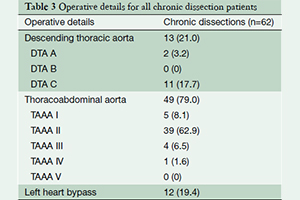Long-term outcomes in thoracoabdominal aortic aneurysm repair for chronic type B dissection
Abstract
Introduction: Open repair for chronic aortic dissection remains a challenging surgical option. Different centers report diverse experiences and outcomes pertaining to thoracoabdominal aortic aneurysm repair (TAAAR) for chronic type B dissection. We highlight our center’s experience and results on a background of published literature and current evidence.
Methods: We reviewed 214 open TAAAR performed between October 1998 and February 2014. Of these, chronic type B dissection was present in 62 (29.0%) patients. We reviewed these patients in terms of demographics, operative characteristics and outcomes. Thirteen (21.0%) patients had surgery on the descending thoracic aorta [Category A =2 (3.2%), B =0 (0%), C =11 (17.7%)] and 49 (79.0%) in the thoracoabdominal thoracic aorta [Crawford extent I =5 (8.1%), extent II =39 (62.9%), extent III =4 (6.5%), extent IV =1 (1.6%)]. Left heart bypass was used in 12 (19.4%) patients.
Results: The composite in-hospital endpoint, adverse outcome—defined as operative death, renal failure necessitating dialysis at discharge, stroke, or permanent paraplegia or paraparesis—occurred after 28 (45.2%) procedures. There were 14 (22.6%) operative deaths. In-hospital mortality was seven (16.3%) out of 43 elective patients, and increased to seven (36.8%) of the 19 non-elective ones. Permanent paraplegia or paraparesis occurred after two (3.2%) cases, stroke occurred after seven (11.3%) and renal failure requiring dialysis occurred after 16 (25.8%). Mean follow-up time was 3.2 years and actuarial 5-year mortality was 27.4% [nine (14.5%) elective and eight (12.9%) non-elective patients].
Conclusions: TAAAR in chronic type B dissection carries a substantial risk of early adverse outcomes. The results could be well alleviated with cases directed towards specialized regional and supra-regional centers. Although the endovascular approaches offer relatively low mortality and morbidity, there is a lack of long-term data and guidelines on their use. There is a need for a multidisciplinary international registry on the management of thoracoabdominal aortic aneurysms and dissection. This would provide a degree of guidance on relevant clinical and surgical judgments and outcomes.
Cover






